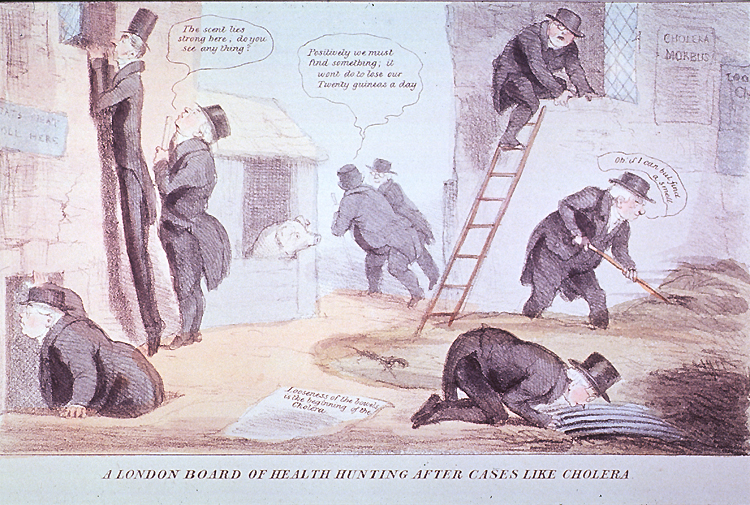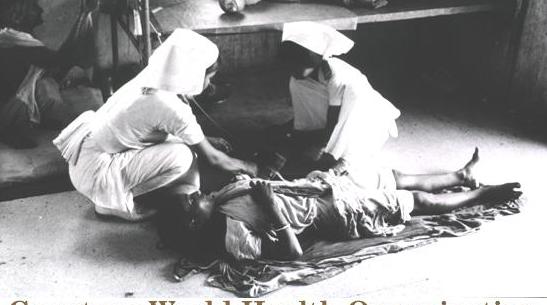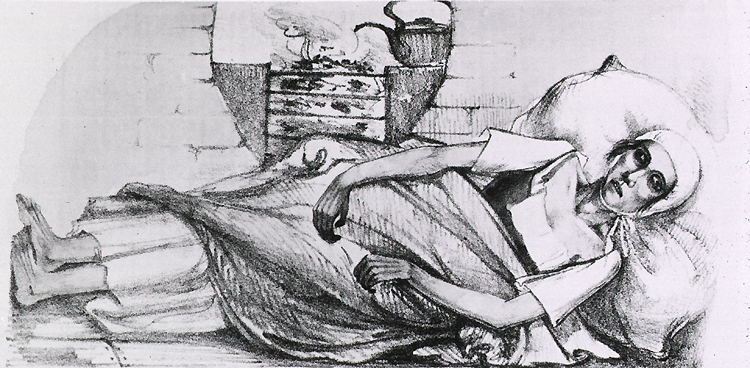Introduction
Epidemic cholera is an acute, painful, and often fatal disease which ravaged nearly the entire world during several severe outbreaks over the course of the 19th century. It is a diarrheal disease which can cause death by dehydration to an untreated patient in a matter of hours and is extremely contagious in communities without adequate, modern sanitation, as most of the world was in 1817 when it first left India. News of its spread and impending approach often sent panic into entire nations, and health professionals were largely at a loss as to how to treat or prevent it until modern epidemiological and laboratory techniques were developed later in the century. Cholera is still a concern for global public health.
About the Project
The National Library of Medicine has digitized 518 English language monographs dating from 1817 to 1900 dealing with the cholera pandemics of that period. The selection of cholera was in part inspired by the 315-page "Bibliography of Cholera" compiled by John Shaw Billings in 1875 for John M. Woodworth's massive report, The Cholera Epidemic of 1873 in the United States. This extensive bibliography by Billings meant to include all published monographs and journal articles "which relate mainly or entirely to cholera." In reading through the bibliography, it appears to be a precursor, perhaps a "pilot project," to the great Index Catalogue of the Library of the Surgeon General's Office, which began coming out in 1880.
While the items chosen for this project were not selected directly from Billings' bibliography, nearly all of them dating before 1874 appear there. Only monographic items, such as pamphlets and separate volumes, were selected for this project, with the hope that in the future we will be able to add the journal literature in English and that other institutions in other countries will be able to scan the literature appearing in other languages.
Billings did not mention images in his bibliography, but because we have the opportunity to show them separately from the texts, we have chosen to do so here. The cartoons and social satire regarding cholera are primarily from the Images from the History of Medicine (IHM) database, as are the photographs of physicians who contributed to the debate about cholera.
Cholera as a Disease
Cholera is caused by the Vibrio cholera bacterium, which primarily affects the digestive tract. It is extremely acute, with a gestation period of one to two days, and upon onset, causes severe diarrhea and sometimes vomiting, both leading to dehydration that can cause death in a matter of hours. Those who are malnourished or already have intestinal parasites can be at especially high risk of death. The cure is relatively simple: oral or intravenous hydration administered as quickly as possible. Knowledge of bacterial infection, contagion, and the physiology of the body's water were all lacking in the early 19th century, though scientists began discovering clues to these issues as the century wore on. Also, see the MedlinePlus Health Topic entry on cholera.
The Pandemics
Cholera seems to have first appeared in India and may have been endemic there causing outbreaks as far back as the 16th century. In 1817, however, a particularly virulent outbreak struck in Eastern India in the state of Bengal and quickly spread to other parts of the subcontinent. After spreading to Persia, the Middle East, and Southeast Asia, it reached the Mediterranean in 1823 and died down, ending the first pandemic.
In 1827, cholera flared up again in India, and by 1829 it began appearing in Russia and heading west toward Europe and the Middle East, finally reaching North America in 1832 via Quebec, Montreal and New York. As with the previous pandemic, the death toll was high, for instance killing as many as 7,000 people in 18 days in Paris in March and April of 1832.
Because this second pandemic affected Europe and the Americas so directly, the press and the medical establishments took ample notice, and publishing in both areas was prolific. Physicians struggled to describe the disease, find its cause, and discover effective treatments. Municipalities published accounts of their own epidemics and sent representatives to affected areas to determine possible causative factors. Quack doctors and eccentrics offered untested remedies to an anxious and often panic-stricken public.
These patterns were repeated as the disease struck again and again in the 19th century, in four other major pandemics, most notably in 1848-50, 1854-57, 1865-67, and 1873-74.
Copyright Information
All of the works included in Cholera Online: A Modern Pandemic in Texts and Images are in the public domain, usually because of their dates, though sometimes because they were published by a government body. Also, the National Library of Medicine does not claim copyright on the electronic files created for Cholera Online: A Modern Pandemic in Texts and Images, so images and text files created for the project can be published or distributed without seeking permission. We do ask that such materials be labeled, "Courtesy of the National Library of Medicine."
For more information about copyright, please visit:
Historical Collections Copyright Information and
NLM Copyright Information.
For more information about the project, please contact the NLM Support Center.
You can view the previous version of this website archived in the NLM Institutional Archives web collection.



